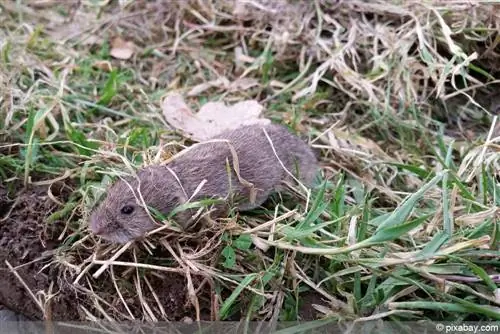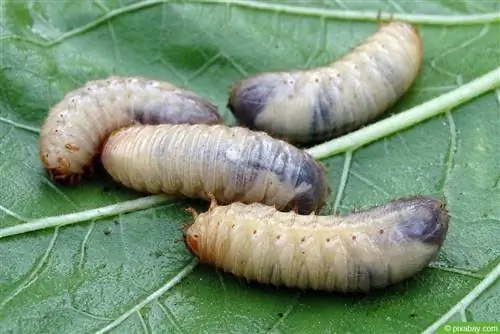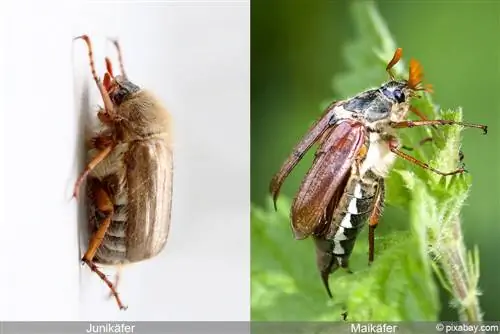- Author admin [email protected].
- Public 2023-12-17 03:39.
- Last modified 2025-01-24 12:45.
All types of fleas belong to the genus of fleas. In entomology, the flea beetle, on the other hand, is classified in the order of beetles (Coleoptera). The “flea” in the name is due to the flea beetle’s strong hind legs. When disturbed, these allow him to hop away like a flea. Monoculture, dry and uncultivated soil in particular favor the population of this beetle species. Flea beetles prefer to attack cotyledons and tender stems. So it's time to be vigilant and take the right measures to combat rapeseed flea beetle in good time.
Appearance
The flea beetle (Psylliodes) from the leaf beetle family (Chrysomelidae) is tiny at just 2 to 3 millimeters. The rapeseed flea beetle is metallic blue-black to brown. An oval-shaped body sits on 3 pairs of legs, with the hind legs being particularly strong. The dirty white larvae are almost twice as large and have a dark brown head. In the vegetable beds we usually come across the large rapeseed flea beetle (Psylliodes chrysocephalus).
Lifestyle, life cycle
The finished beetle emerges from the ground in summer. Older vegetable stands and weeds then feed it. But soon, when it gets really hot, the flea beetle looks for shady places at the edge of the forest or field. It wasn't until the beginning of September that he made another major attack on the vegetable stocks. The females are then referred to as maturation feeding. Shortly afterwards they lay their eggs in the ground, close to the richest food sources. Egg laying can last until next spring. Therefore, a mild climate in autumn and winter is extremely favorable for the population. The larvae hatch from September to April. They immediately bore into the outer leaf stalks. As they grow larger, it extends further into the stems. This damage can lead to total crop failure. At the end of spring the larvae pupate in the soil. After one or two months, the young beetles hatch, happily eat their way through the rapeseed or vegetables and the game begins again. The adult beetles overwinter in hedges, forests or leaf litter.
Nutrition
Food is needed most from April to August. It usually starts in spring with the first wild herbs before they attack the young vegetable seedlings. Plants from the cruciferous family (Brassicaceae) are very popular. They seem to particularly like the young leaves and stems of the plants. Every now and then the larvae attack young roots in spring. The menu preferably includes:
- Ackermustard
- Hederich
- Shepherd's Purse
- Hungerblümchen
- Nasturtium
- Cabbages
- Peppermint
- Raps
- Radish
- Beets
- Rocket
- Steinkraut
malicious image
When the days get warmer in spring, you will initially be able to identify a flea beetle infestation by tiny holes in the leaves. The rapeseed beetle then comes out of its winter quarters and eats small holes of up to four millimeters between the leaf veins. This is also called a hole or window corrosion. If the young plants grow slowly, either due to too much cold or drought, they are particularly at risk. The flea beetles then eat so much of the leaf surface that the plants die. The larvae feed forward in the leaf stalks to the main stem. Tiny entry and exit holes can be seen on the leaf stalks. Fecal residue, especially in the heart of the plants, also indicates an infestation of flea beetle larvae. Shoots damaged by this leaf miner can then burst open on frosty days. Plants damaged in autumn have reduced winter hardiness and are more susceptible to disease. The plants' growth is inhibited.
Tip:
When gardening between the beds, the tiny pests can also jump on people. They don't cause actual bites on the skin, but they can leave skin irritation. However, unless you have an allergy, it is harmless.
Prevention
As always when it comes to diseases and pests, good prevention is the best way to combat them. There are a number of preventative measures against rapeseed beetles, or against all types of beetles:
Crop rotation
A wide crop rotation should be preferred, especially when growing vegetables. This means waiting at least three years until vegetables from the cruciferous family or rapeseed are sown on the same bed again. Even a proximity that is too close should be avoided the next time you sow.
Mixed Culture
Within the bed you can prevent mass infestation by creating a mixed culture with the endangered plants and spinach, lettuce, onions or garlic.
Weeds
Keep the beds as free as possible from weeds from the cruciferous family.
Seeds
Prefer he althy and well-growing seeds. The faster the plants grow large and strong, the less likely the flea beetles are to cause them serious damage.
Sowing
The better and faster the seeds germinate, the better the damage is prevented. So don't sow too densely and ensure that the young plants can develop well.
Mulching
A layer of mulch not only inhibits the growth of weeds, but also the colonization by flea beetles and their egg laying.
Care
Flea beetles prefer to be undisturbed. They prefer dry soils. Anyone who regularly loosens the soil, pulls weeds and keeps the soil moist makes it particularly uncomfortable for the pests.
Combat
The rapeseed flea beetle is one of the largest pests in agriculture. They are conventionally combated with insecticides from the pyrethroid class of active ingredients. However, the first resistances are already forming. For private cultivation, only preventive measures and natural or home remedies should be used.
The use of predators
Parasitic wasps, ground beetles and predatory beetles are the natural predators. They can be applied directly to the affected plants. The eggs of parasitic wasps can be bought in specialist stores or ordered online. They like to lay their eggs in old logs. Anyone who wants to force settlement can try to provide them with living space. To do this, simply drill small holes in wooden trunks or branches and lay them out. With a bit of luck, the insect hotel will be accepted.
Shaking Plants
Plants that are already infected can be shaken or brushed along with a broom. The flea beetles jump away immediately. The most effective way is to place boards or cardboard previously coated with glue around the plant.
Spraying plants with home remedies
An infusion or manure made from wormwood, tansy, nettle, garlic or onions is well suited.
Insert lure plant
You should sow radish, for example, as early as possible. The flea beetles go to the plant that develops earliest. If a lot of specimens have gathered there over time, they can be collected there in a bunch or sprayed.
fleece
While the seeds are sprouting, a layer of mulch or fleece can protect them from flea beetles.
Glue traps
The use of adhesive traps is also effective and harmless. Their use is most effective the sooner they are used. To do this, you attach so-called yellow boards to sticks and insert them just above the ground, at the height of the seedlings. The boards should always be at the same height as the respective plants.
Insecticides
As already mentioned, insecticides should only be used as a last resort, especially when it comes to vegetables. Contact insecticides and products containing the ingredient azadirachtin are usually used to combat flea beetles. This substance inhibits the development of the larvae.
Conclusion
There are numerous ways to combat these little pests. When signs of feeding first appear, you need to act quickly. In small gardens, regular watering and raking as well as varied planting in the bed are the best way to limit damage. A mixed culture with vegetables from other families also helps against excessive pest infestation. This enriches the menu and also visually enhances the vegetable beds.






